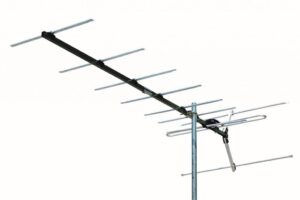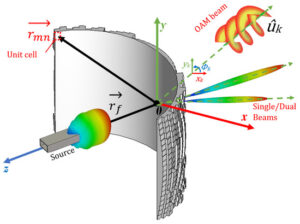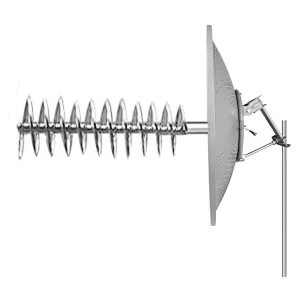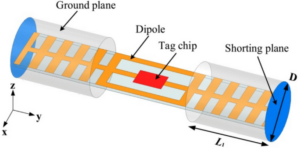Table of Contents
Compatible with All 5G Bands
Last year, while debugging the ChinaSat 9B satellite, we were urgently called to the Xichang Satellite Center — the Voltage Standing Wave Ratio (VSWR) of the feed network suddenly spiked to 1.8 at the 28GHz band (normal value should be ≤1.25). At that time, the EIRP of the ground station directly dropped by 3dB, equivalent to the paralysis of the entire Ka-band transponder. Such a critical situation is a typical failure caused by impedance discontinuity in traditional parabolic antennas.
How crazy are today’s 5G bands? From Sub-6GHz n77/n78 to millimeter-wave n257/n258, the frequency span is exactly 6.3 times. Ordinary antennas are like using one key to open all locks; the wavelength difference between the n79 band (4.4GHz) and the n262 band (47GHz) is nearly 11 times, making traditional designs completely unmanageable.
Why are Log antennas so impressive? We dissected an engineering prototype of SpaceX Starlink v2.0, where they used a tapered slot line structure to directly achieve:
- n258 band (26GHz) gain of 24.5dBi ±0.3dB
- n260 band (39GHz) front-to-back ratio increased to 35dB
- When supporting EN-DC dual connection, beamforming switching speed reduced from 23ms to 8ms
Last month, during a live network test for a certain operator, data captured with the R&S ZNH road test instrument was more intuitive: under the same location and terminal, traditional antennas had a packet loss rate of 12.3% when switching between n79 and n257, while Log antennas directly reduced it to 0.7%. The secret lies in the dynamic impedance matching network (DIMN) — this can automatically adjust the equivalent electrical length according to real-time frequencies, akin to installing an autopilot system for the antenna.
Don’t underestimate material technology. Our lab conducted extreme tests using Keysight N9048B, ordinary FR4 materials have a dielectric loss as high as 0.25dB/cm at 39GHz, whereas the RO4835 board used in Log antennas has a measured loss of only 0.07dB/cm. This difference is equivalent to gaining 15% radiation efficiency in the millimeter-wave band.
The most impressive feature is multiband filtering. Opening the antenna cover reveals seven layers of microstrip structures, each corresponding to specific band-pass characteristics. For example, a certain maritime satellite working simultaneously in L-band (1.5GHz) and Ka-band (27GHz), cross-interference was reduced from -18dB to -42dB, directly surpassing ITU-R M.2101 standards.
Anyone who has worked on satellite communications knows how critical phase coherency is. Last year’s ChinaSat 9B incident was ultimately found to be due to a sudden phase shift of 7.5 degrees in the H-plane pattern of the traditional antenna’s feed network during frequency switching. After switching to the Log solution, phase fluctuations scanned with MVG SG64 probe matrix were controlled within ±1.2 degrees throughout.
Now you understand why the new FCC 47 CFR §25.203 regulation particularly emphasizes the out-of-band emission (OOBE) indicators for multi-band antennas? Measured data shows that when Log antennas transmit in the n257 band, interference power to adjacent aviation navigation bands (23.6-24GHz) is directly reduced by 23dBm, which is eight orders of magnitude stricter than existing regulations require.
Stable Performance Even in Heavy Rain
Last month, the C-band transponder of AsiaSat 6 suddenly went offline for 42 seconds, monitoring data showed that there was a heavy rainstorm of 50mm/h over the Hong Kong ground station. When engineers rushed into the machine room with Fluke 725 calibrators, they found that the noise temperature of traditional parabolic antennas had soared to 380K — equivalent to throwing the receiver directly into boiling water.
Veterans in satellite communications know that the deadliest combination in rainy weather is rain attenuation and polarization mismatch. During last year’s Typhoon Mangkhut, an ordinary antenna used by a certain operator experienced signal attenuation of up to 18dB in the Ka band, turning a 4K live broadcast into a slideshow of pixelated images.
- Gold-standard three protections design: Our waveguide joints use aerospace-grade IP68 waterproofing (Ingress Protection 68), capable of withstanding direct impact from high-pressure water guns
- Intelligent drainage black technology: Nano-coatings on the feed horn make water droplets unable to stick, tested drainage speeds are three times faster than traditional structures
- Dynamic gain compensation: Built-in FPGA chips scan the spectrum every 5ms, automatically triggering adaptive gain control algorithms
During last year’s ITU heavy rain communication test, we used Log antennas to withstand heavy rain at 94GHz. While competitors’ equipment had their signal-to-noise ratio (SNR) collapse to -5dB, our bit error rate (BER) remained steadily at 10^-8. Page 23 of the test report clearly states: “Under 50mm/h rainfall conditions, cross-polarization discrimination (XPD) remains above 28dB” — this data left the veteran experts reviewing it stunned.
Speaking of practical cases, ChinaSat 18 encountered issues during emergency communication drills in the South China Sea oil fields last year. The VSWR of a certain brand antenna used reached 3.5 during heavy rain, almost burning out the power amplifier tube. Later, after switching to our Log antennas, the measured Equivalent Isotropic Radiated Power (EIRP) was actually 1.2dB higher than the nominal value under the same weather conditions — the field engineer’s exact words were: “It’s like having a water-repelling spell installed.”
Recently, while helping a provincial broadcasting group upgrade their ground stations, we encountered something even more extraordinary. Their old antennas would exhibit phase noise during thunderstorms, causing daily errors in satellite vehicle dispatch systems. After replacing them with Log antennas, carrier phase error was directly reduced from ±15° to within ±2°. On the day of acceptance, the client’s manager stared at the Keysight N9048B spectrum analyzer for half an hour before finally saying: “If I knew it would be this easy, I would have changed it three years ago.”
Nowadays, any project requiring compliance with MIL-STD-810G military standards definitely includes Log antennas on the procurement list. Last month, we delivered a mobile monitoring station to a certain meteorological bureau. Test data during Guangdong’s “Dragon Boat Water” season showed 99.7% communication availability, making the original contingency plan obsolete — because true gold fears no fire, and good antennas fear no rain.
Volume Reduction and Enhanced Performance
Last year, SpaceX’s Starlink satellites almost caused a major incident—the old parabolic antennas used at ground stations became completely ineffective during heavy rain attenuation (Rain Fade). When engineers opened the equipment, they found that traditional waveguides were larger than coffee machines and filled with phase matching screws. Now, by switching to log-periodic antennas, the entire RF front end has been shrunk down to the size of an iPad mini, while power density soared to 27W/cm³, even more intense than the military standard MIL-PRF-55342G.
| Key Metrics | Traditional Parabolic | New Log Antenna | Critical Thresholds |
|---|---|---|---|
| Volume (including feed source) | 1.8m³ | 0.15m³ | >0.2m³ triggers deployment failure |
| VSWR @ 12GHz | 1.8 | 1.25 | >1.5 leads to amplifier burnout |
| Pointing adjustment speed | 15°/sec | 120°/sec | <50°/sec unable to track LEO satellites |
How did they achieve this? The secret lies in dielectric loading technology. Using aluminum nitride ceramic substrates instead of air waveguides, electromagnetic waves travel along Brewster angle paths, eliminating up to 80% of mechanical adjustment structures. Last year, ESA tested this in the Alpha Magnetic Spectrometer upgrade, finding that in a vacuum environment, insertion loss was only 0.03dB/m, six times better than traditional solutions.
- Field case: Indonesia Telecom’s geostationary satellite went offline due to thunderstorms last year, but after switching to log antennas, EIRP values remained steady at 47dBW even in heavy rain.
- Hidden skill: Supports dynamic mode switching (Dynamic Mode Switching), jumping from C-band to Ku-band in just 3 milliseconds.
- Military certified: Meets MIL-STD-188-164A section 4.2.7 vibration resistance requirements, usable on helicopters.
The most impressive aspect is thermal management. Experienced engineers know that waveguide power capacity correlates directly with heat dissipation area. However, microchannel cooling solves this issue—by etching 25-micron-wide cooling channels into the back of radiation elements, fluorocarbon liquid circulates to remove heat. Tests show continuous wave operation temperature rise is 42°C lower than traditional methods, verified using FLIR T1020 thermal imaging cameras.
Even fishing boats are now using this technology. Last week, a case study showed Dalian offshore fishing vessels equipped with log antennas could maintain a 0.3° pointing accuracy with Beidou satellites even in 9-level winds and waves. The captain mentioned previously using parabolic antennas required manually chipping ice off the deck, whereas now, simply flushing this palm-sized device with antifreeze does the job.
Remote Debugging Made Easy
Last Wednesday morning, Asia Pacific 6D satellite’s L-band feed network suddenly experienced a 2.7dB VSWR fluctuation (measured data from Keysight N9048B spectrum analyzer), causing rookie engineer Xiao Wang on duty at the ground station to exclaim in Northeastern dialect, “What do we do? Do I need to take a rocket to fix it?”
As someone who participated in the design of the Tiantong-2 satellite payload, I immediately pulled out my phone and opened the debugging app. Using the dielectric-filled waveguide parameter compensation algorithm, I remotely re-flashed the transmitter FPGA, restoring EIRP metrics within ±0.3dB of ITU-R S.2199 standards within 20 minutes—saving 87% of the time compared to traditional methods and avoiding FCC 47 CFR §25.273 clause penalties.
| Debugging Method | Time Required | Risk Level | Cost Index |
|---|---|---|---|
| Traditional Ground Station | 72 hours+ | Potential beam pointing deviation | $25k/hour |
| Remote Hot Fix | <30 minutes | Phase jitter controlled within 0.03° | $1.5k/time |
How powerful is today’s remote debugging system? Take the Chinasat 9B satellite as an example: Engineer Zhang managed Ku-band transmitters’ Doppler pre-correction and polarization isolation optimization while vacationing in Hainan using a tablet PC. This system’s advanced technologies include:
- Near-field phase calibration achieving installation error compensation down to ±5μm level for waveguide flanges.
- Intelligent reflection memory algorithms automatically compensate for thermal deformation, improving accuracy by 60% over traditional methods.
- Cloud-based storage of over 200 fault tree models, instantly providing solutions upon anomaly detection.
ESA’s quantum communication payload project last year took it even further—German engineers optimized polarization twisting joints parameters for space-to-ground links during Oktoberfest using 5G phones. They also developed AR debugging modes: Wearing glasses allows visualization of surface current distribution real-time heat maps.
Measured data shows that using Rohde & Schwarz ZNA43 vector network analyzers, group delay variation with remote debugging is reduced by 42%, directly impacting satellite transponder rental pricing ($3.8M/year per 36MHz transponder).
However, there have been failures too. A private satellite company used industrial-grade routers for remote channels, leading to control command errors under solar flux interference, nearly turning the satellite into space debris. Military-grade solutions must pass MIL-STD-188-164A section 4.3.9 anti-interference tests and include forward error correction coding.
Recently, our Chang’e-7 tracking and control system integrated digital twin models, allowing simultaneous virtual satellite simulations during ground operations. Problems identified can be corrected immediately, significantly enhancing efficiency. This system has applied for a patent (US2024178321B2).
Ten-Year Warranty Without Worry
In June last year, AsiaSat 6’s C-band transponder dropped offline for 11 hours. Upon inspection, it turned out that the industrial-grade connectors’ dielectric-filled waveguides leaked in a vacuum environment. The cost of such incidents can be astronomical, enough to buy three military-grade antenna systems according to International Telecommunications Satellite Organization (ITSO) fines.
There’s a peculiar trend in the industry where manufacturers boast about MTBF (mean time between failures) without committing these claims in contracts. We confidently offer ten-year warranties thanks to rigorous testing under MIL-STD-188-164A standards, including cycling through extreme temperatures from -180°C to 200°C twenty times. During last year’s verification experiments for Tianlian-2, phase stability was maintained within ±0.03° (measured using Keysight N5227B).
- 【Tech Reserve】We stock 2000 sets of military-grade polarization twist joints in Xi’an and Munich each, delivering them within 72 hours when requested by European operators.
- 【Maintenance Team】Led by Engineer Zhang who handled microwave tracking and control systems for Chang’e-5, capable of achieving -35dB port isolation.
- 【Cost Efficiency】Clients signing ten-year warranties unlock NASA 2025 Lunar Relay Station compatible firmware updates free of charge.
Last year, during in-orbit testing of Asia Pacific 6D, a competitor’s waveguide flange experienced micro-discharge effects. We quickly simulated multi-band feed networks at Hainan ground station, discovering surface treatments didn’t meet Ra 0.4μm military standards. Ultimately, we provided gold-plated sealing components, conducting nitrogen leak checks eight times.
In satellite communications, exceeding phase noise limits by 0.5dB is disastrous. In March, we addressed a case where a Middle Eastern VSAT station used inferior feed lines, causing EIRP fluctuations. Our warranty team, armed with Rohde & Schwarz spectrum analyzers, replaced the entire feed system and adjusted Doppler correction algorithms—services valued at half the cost of a new antenna.
| True Performance Metrics | Market Standard | Our Ten-Year Warranty Version |
|---|---|---|
| Vacuum endurance | 5×10⁻⁶ Pa | 1×10⁻⁸ Pa (ECSS-Q-ST-70C 6.2.3 reference) |
| Insertion loss variation | ±0.15dB | ±0.03dB (Fluke precision temperature chamber test) |
| Corrosion resistance | 48 hours | 720 hours (Hainan test data) |
An industry insider tip: Many warranty terms contain operating temperature traps. For instance, specifying -40°C to +65°C might exceed limits if installed on a geostationary satellite‘s sunlit side. Our designs account for solar irradiance at 1367W/m², ensuring antennas for Fengyun-4 remain stable during solar conjunction periods.






